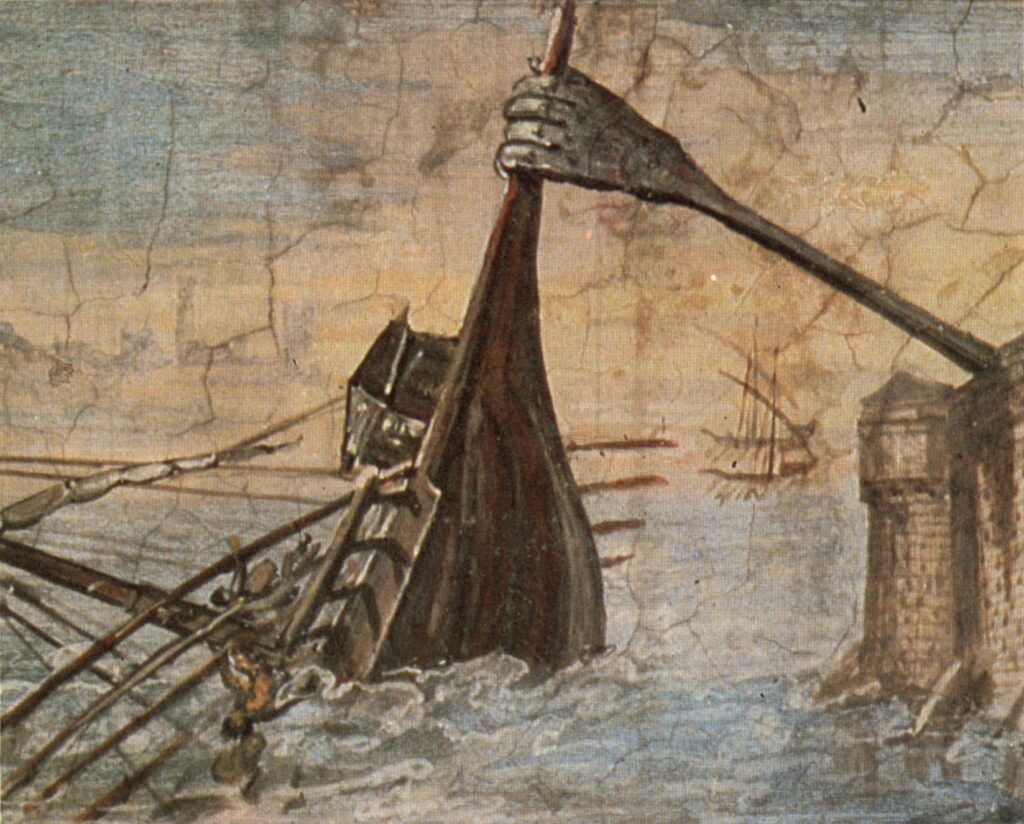In 213 BC, Rome and Carthage were at war, and Roman leaders were eyeing the Greek city-state of Syracuse as the next target in their campaign.
Syracuse was strategically important because it was located between the two warring empires on the island of Sicily. Unfortunately for the Romans, taking the city would prove very difficult.
Romans assaulted the city for over a year from both the land and the sea. Commander Appius Claudius Pulcher attempted to breach the city’s walls from the north. At the same time, from the south, Marcus Claudius Marcellus dispatched a fleet of 60 Roman warships, called quinqueremes, each one so large that they required 300 rowers.
It was an impressive show of naval power, but it was to no avail. Each time the ships got close to the city, they were repelled.

What stopped the formidable Roman fleet?
For one thing, the Greeks had a wide range of defensive weaponry, including crossbows and catapults. But something else, something strange, stands out from historical descriptions of the battle.
Various Roman writers describe a giant crane-like weapon equipped with an arm that could swing out from behind the city’s walls, grab a ship by the prow, and lift it out of the water as if it were nothing more than a toy.
This was the iron claw of Archimedes, and if the stories were true, this deadly invention would have been truly terrifying.
But did such a weapon really exist?
Archimedes and His War Machines
The iron claw (also referred to as the iron hand), if it did ever exist, is credited to Archimedes, one of the greatest mathematicians of all time.
You see, Archimedes was far more than a brilliant theoretician. As Syracuse’s most famous resident, he designed a system of defense strong enough to hold off a Roman assault.
Even without Archimedes’ inventions, Syracuse was blessed with natural features that made it difficult for invaders to penetrate. Its main harbor could be closed off by stretching chains across its mouth.
Mountain ranges and steep cliffs surrounding the city made invasion by land nearly impossible. The Romans’ only realistic option was to attack Achradina, a thousand-yard section of shallow, rocky coastline that was defended by a seawall.
At Achradina, the Romans did their best to get over the city’s walls. They lashed together quinqueremes to create larger, more stable vessels that wouldn’t capsize.
These massive ships were known as sambucae, and each one had a large contingent of Roman soldiers who used scaling ladders to try and breach the city’s ramparts. While sambucae approached the city’s walls, quinqueremes loaded with archers and javelineers floated nearby, unleashing volleys of projectiles as covering fire.
The Romans had clearly planned out their attack, but Archimedes was one step ahead. His defensive structures included cranes that dropped heavy stones onto any ship within range.
Greek crossbows and stone launchers caused damage to Roman attackers before they could even get near enough to fight back. In addition, large catapults launched projectiles that traveled hundreds of yards, making it difficult for the Roman ships to stay out of harm’s way.
And then there was the iron claw. Plutarch, writing about the siege of Syracuse, gives us this detailed description of the famous iron hand of Archimedes:
At the same time huge beams were run out from the walls so as to project over the Roman ships: some of them were then sunk by great weights dropped from above, while others were seized at the bows by iron claws or by beaks like those of cranes, hauled into the air by means of counterweights until they stood upright upon their sterns, and then allowed to plunge to the bottom, or else they were spun round by means of windlasses situated inside the city and dashed against the steep cliffs and rocks which jutted out under the walls, with great loss of life to the crews.
Often there would be seen the terrifying spectacle of a ship being lifted clean out of the water into the air and whirled about as it hung there, until every man had been shaken out of the hull and thrown in a different direction, after which it would be dashed down empty upon the walls.
According to this description, the iron claw could extend out over a ship and, grabbing it by the prow, could lift it up and drop it down again, causing the ship’s nose to crash into the water. This would be a truly extraordinary feat considering the size of Roman warships and the available technology at the time.
But was it really possible?
The Iron Claw: Fact or Fiction?
This is a question that historians have wrestled with for some time. Unfortunately, Archimedes left behind no designs of his iron claw.
Without any instructions from the inventor himself, it’s been left up to researchers to test the question using scale models based on descriptions left by writers like Plutarch.
Since there’s no diagram showing what the iron claw would have looked like or how it would have operated, these models vary depending on each researcher’s own interpretation.
One notable example was featured in a 1999 BBC documentary, which showed that a 25-metric-ton fishing boat could be lifted up out of the water using an anchor as a grappling hook and a large team of men pulling ropes attached to a wooden beam.
But considering that each quinquereme weighed about 100 metric tons, it would have taken an incredible amount of man or animal power to lift one. What’s more, calculations show that the wooden beam where the claw was attached would have to be much stronger than the available materials at the time would have allowed for.
So, what was the iron claw of Archimedes? Was it truly the terrifying weapon that lifted entire ships out of the water?
In the end, we don’t have definitive proof that an iron claw really did wreak havoc on the Roman attackers during the siege of Syracuse.
But considering the brilliance of Archimedes and his talent for constructing other deadly war machines, some version of his iron hand may have indeed existed.
Unfortunately for Archimedes, his inventions couldn’t save him or his city. After a nearly year-long blockade that reduced the city’s food and supplies, Roman soldiers finally broke through during a festival.
As Syracusans celebrated throughout the night, soldiers climbed over an undefended wall section. Once inside, they ransacked houses, massacred their inhabitants, and set the city on fire.
The 74-year-old Archimedes, who had done more than anyone to protect his city, was killed during the slaughter. The brilliant inventor may have died, but his iron claw lives on. It remains a mystery that confounds and inspires and continues to test our understanding of ancient technology.
Source
Young, C. K. “Archimedes’s Iron Hand or Claw – a New Interpretation of an Old Mystery.” Centaurus, vol. 46, no. 3, 2004, pp. 189–207., https://doi.org/10.1111/j.1600-0498.2004.00009.x.
Rorres, Chris. Archimedes in the 21st Century: Proceedings of a World Conference at the Courant Institute of Mathematical Sciences, Springer International Publishing, Cham, 2017.
“Archimedes.” Encyclopædia Britannica, Encyclopædia Britannica, Inc., 5 Jan. 2023, https://www.britannica.com/biography/Archimedes.
Archimedes’ Claw: Sources, https://www.math.nyu.edu/~crorres/Archimedes/Claw/sources.html.

